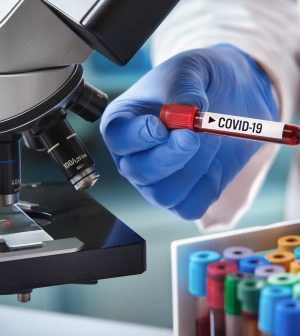- Navigating Your Midlife Crisis: Embracing New Possibilities
- City Raccoons Showing Signs of Domestication
- Mapping the Exposome: Science Broadens Focus to Environmental Disease Triggers
- One Week Less on Social Media Linked to Better Mental Health
- Your Brain Changes in Stages as You Age, Study Finds
- Some Suicide Victims Show No Typical Warning Signs, Study Finds
- ByHeart Formula Faces Lawsuits After Babies Sickened With Botulism
- Switch to Vegan Diet Could Cut Your Greenhouse Gas Emissions in Half
- Regular Bedtime Does Wonders for Blood Pressure
- Dining Alone Could Mean Worse Nutrition for Seniors
Why Some Folks Get COVID and Others Never Do

Everyone knows someone who gets COVID-19 repeatedly, and they probably also have that annoying friend who’s never had the illness. What gives?
According to new research, over the long-term it’s probably genetics that drives an individual’s level of susceptibility to SARS-Cov-2.
“Our results suggest that initially, differences in shared home environment influenced who was infected with COVID-19 more than genetic differences,” explained study lead author Katie LaRow Brown, a Ph.D. candidate at Columbia University in New York City.
“Over time, however, the importance of these differences in shared home environment decreased — and the importance of genetics increased — eventually eclipsing shared home environment,” she said. Brown spoke in a news release from Cedars-Sinai in Los Angeles, which was also involved in the research.
According to background info, since the pandemic began over 340 million Americans have been infected by the SARS-Cov-2 coronavirus.
However, the role that environment and genetics may play in who gets infected is still poorly understood.
In the new study, Brown and colleagues looked at data from the electronic health records of patients at New York-Presbyterian/Columbia University Irving Medical Center.
Almost 13,000 of the patients received conclusive results on COVID-19 PCR tests taken between late February 2021 and late October 2022.
Typically, patients came from families where an average 2.5 members had contracted COVID-19.
Parsing out genetics versus environmental factors, the researchers found that the relationship changed over time.
Earlier in the pandemic, a person’s genetics accounted for about 33% of the variation in their susceptibility to COVID-19, but by the second half of the study, genetics’ role in susceptibility rose to 70%.
Looking at the severity of COVID illness (based on days spent in the hospital), genetics again trumped home environments. The study found that genetics explained 41% of variations in case severity, while shared environment explained 33%.
“We were especially surprised by the percentages of susceptibility,” said senior study author Nicholas Tatonetti.
The findings were published recently in the journal Nature Communications.
“Since this is an infectious disease, we assumed that home environment differences would explain most variation for the entirety of the study,” said Tatonetti, vice chair of operations in the department of computational biomedicine and an associate director of computational oncology at Cedars-Sinai Cancer.
It’s not yet clear which DNA is driving the gap between who gets COVID-19 and who doesn’t. Finding out “is very important in terms of directing resources and defining future research goals,” Tatonetti said.
More information
Find out more about shielding yourself from COVID at the U.S. Centers for Disease Control and Prevention.
SOURCE: Cedars-Sinai, news release, Jan. 31, 2024
Source: HealthDay
Copyright © 2025 HealthDay. All rights reserved.










